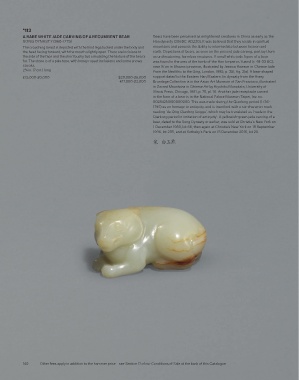Page 142 - Christie's Fine Chiense Works of Art November 2018 London
P. 142
*113
A RARE WHITE JADE CARVING OF A RECUMBENT BEAR Bears have been perceived as enlightened creatures in China as early as the
SONG DYNASTY (960-1279) Han dynasty (206BC-AD220). It was believed that they reside in spiritual
The crouching beast is depicted with the hind legs tucked under the body and mountains and possess the ability to intermediate between heaven and
the head facing forward, with the mouth slightly open. There are incisions to earth. Depictions of bears, as seen on the present jade carving, portray them
the side of the face and the short bushy tail, simulating the texture of the bear’s as unthreatening, harmless creatures. A small white jade fgure of a bear
fur. The stone is of a pale tone, with honey russet inclusions and some snowy was found in the area of the tomb of the Han Emperor, Yuandi (r. 48-33 BC),
streaks. near Xi’an in Shaanxi province, illustrated by Jessica Rawson in Chinese Jade
2æ in. (7 cm.) long
From the Neolithic to the Qing, London, 1995, p. 351, fg. 2(a). A bear-shaped
£15,000-20,000 $20,000-26,000 support dated to the Eastern Han/Eastern Jin dynasty from the Avery
€17,000-22,000 Brundage Collection is in the Asian Art Museum of San Francisco, illustrated
in Sacred Mountains in Chinese Art by Kiyohiko Munakata, University of
Illinois Press, Chicago, 1991, p. 70, pl. 16. Another jade receptacle carved
in the form of a bear is in the National Palace Museum Taipei, Inv. no.
002842N000000000. This was made during the Qianlong period (1736-
1795) as an homage to antiquity, and is inscribed with a six-character mark
reading ‘da Qing Qianlong fanggu’, which may be translated as ‘made in the
Qianlong period in imitation of antiquity’. A yellowish-green jade carving of a
bear, dated to the Song Dynasty or earlier, was sold at Christie’s New York on
1 December 1988, lot 66, then again at Christie’s New York on 19 September
1996, lot 205, and at Sotheby’s Paris on 15 December 2016, lot 20.
宋 白玉熊
140 Other fees apply in addition to the hammer price – see Section D of our Conditions of Sale at the back of this Catalogue

